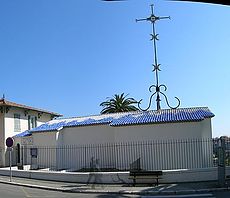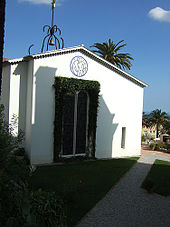- Chapelle du Rosaire de Vence
-
The Chapelle du Rosaire de Vence (Chapel of the Rosary), often referred to as the Matisse Chapel or the Vence Chapel, is a small chapel built for Dominican nuns in the town of Vence on the French Riviera.[1] It was built and decorated between 1949 and 1951 under a plan devised by Henri Matisse.[2] It houses a number of Matisse originals and was regarded by Matisse himself as his "masterpiece." While the simple white exterior has drawn mixed reviews from casual observers, many regard it as one of the great religious structures of the 20th century.
Contents
Background
In 1941, Matisse, who lived most of the year in Nice in the south of France, developed cancer and underwent surgery. During the long recovery he was particularly helped by a young part-time nurse, Monique Bourgeois, who had answered his ad seeking "a young and pretty nurse"[3] and who took care of Matisse with great tenderness. Matisse asked her to pose for him, which she did, and several drawings and paintings exist. In 1943 Monique decided to enter the Dominican convent in Vence, a nearby hill town to Nice, and she became Sister Jacques-Marie. Matisse eventually bought a home at Vence, not far from the convent where the young nun was stationed. She visited him and told him of the plans the Dominicans had to build a chapel beside the girls' high school which they operated in Vence. She asked Matisse if he would help with the design of the chapel. He had never done anything like it, but Matisse agreed to help, beginning in 1947. Father Marie-Alain Couturier, who collaborated on several artistic Catholic churches after World War II, was also involved in the project.
At the age of 77, Matisse began the greatest project of his life and spent more than 4 years working on the chapel, its architecture, its stained glass windows, its interior furnishings, its murals, and the vestments of the priests. It is perhaps the greatest ensemble artwork of the 20th century, and certainly the greatest religious commission. While Matisse had been baptized a Catholic, he had not practiced the religion for many years. He designed the chapel as an artistic challenge.
The story of the friendship and collaboration of Matisse and Sister Jacques Marie is related in her 1992 book Henri Matisse: La Chapelle de Vence (ISBN 2909767000) and in the 2003 documentary Model for Matisse.[3] Sister Jacques Marie died in 2004, aged 84.
The Architecture of the Chapel
The chapel is built on a hillside and one enters by descending a flight of stairs, and then turning to the right. The chapel is in an L shape, with the longer portion directly inside the door. The altar is placed at an angle where the two legs of the L join. The chapel is 15 meters long by 6 meters wide. The longer/larger segment is for the students or townspeople; the shorter section was for the nuns who lived and taught at the school. Both sides face the altar.[4]
Furnishings of the Chapel
The altar is made of warm brown stone, chosen for its resemblance to the color of bread and the Eucharist. Matisse also designed the bronze crucifix on the altar, the candle holders in bronze, and the small tabernacle. The wrought iron candle holder with a flame always burning and hanging from the ceiling was made by local craftsmen who have a special tradition of making wrought iron.
Stained Glass Windows
There are three sets of stained glass windows, upon which Matisse spent a great deal of time. All three sets make use of just three colors: an intense yellow for the sun, an intense green for vegetation and cactus forms, and a vivid blue for the Mediterranean Sea, the Riviera sky and the Madonna. The two windows beside the altar are named the "Tree of Life," but the forms are abstract. The color from the windows floods the interior of the chapel, which is otherwise all white.
Three Great Murals
For the walls, Matisse designed three great murals to be made by painting on white tiles with black paint and then firing the large sections of tile. Each tile measures 12 in.2. Matisse was so crippled with ailments by this time that he could only work from a wheelchair, and he had a long stick with a brush strapped to his arm and pieces of construction paper placed on the wall. He then drew the images, which were transferred to tiles by skilled craftsmen.
St. Dominic
Behind the altar is a large image of St. Dominic, founder of the Order of Dominicans and by tradition founder of the practice of the rosary for Catholics. He was a 13th century wandering preacher from Spain. His followers wear a white garment, or habit, with a white scapular hanging straight down the front. The simplest but most powerful of lines was created by Matisse to depict the saint.
Virgin and Child
On the side wall there are abstract images of flowers and an image of the Madonna and Child, all created in black outlines on the white tiles. Rather than clasping the child to herself, as she is usually depicted, Matisse chose to show Mary offering her son to the whole world.
Stations of the Cross
On the back wall of the chapel are the traditional 14 stations of the cross. Although the 14 stations are usually depicted individually, Matisse incorporated all of them on one wall in one cohesive composition. The series begins at the bottom left as Jesus is brought before Pilate and condemned. The stations follow Jesus' progress carrying the cross. At the top in the center are the three most powerful images - The Raising of the Cross with Jesus' body nailed to it, the actual Crucifixion, and then Taking the Body of Jesus Down. The center panel has a straight vertical and horizontal composition, while the two surrounding stations have strong diagonal lines leading to the head of Jesus on the cross.
Sets of Vestments
Matisse also designed the priests' vestments for the chapel, using the traditional ecclesiastical colors of the religious seasons: purple, black, pink/rose, green, and red. The Pope requested that the nuns send the vestments to Rome to be put in the Vatican's new museum of modern religious art. The nuns made copies of five of the sets of vestments, including chasuble, maniple, stole, and covering of the chalice, and sent them to Rome.
Remainder of Chapel Area
The outside of the chapel is white. The top of the roof is decorated with a blue-and-white zigzag pattern and carries an elaborate metal cross with a bell.
There is a small gift shop associated with the chapel where visitors may purchase postcards and other mementos of the chapel; income goes to support the nuns and the chapel. There are also two doors in carved wood, designed by Matisse, for the confessionals. Along the hallway to the gift shop are photos of Matisse designing the chapel. There are also some of Matisse's original sketches for the Stations and vestments.
Maquettes for all the vestments made, as well as for a number never actualized, were made by Matisse on brown wrapping paper and black construction paper. They can be seen in the Pompidou Center in Paris.
The high school has been closed for a number of years, and only a few elderly nuns still live there.
References
- ^ http://www.bartleby.com/65/ma/Matisse.html , website, accessed July 30, 2006
- ^ http://www.mystudios.com/art/modern/matisse/matisse.html website, accessed July 30, 2006
- ^ a b French Professor Directs "Model for Matisse", Carnegie Mellon Today, 30 June 2003
- ^ Billot, Marcel, ed.; "Henri Matisse: The Vence Chapel, The Archive of a Creation," (Skira:1999)
External links
- Official site, with opening hours, photographs, etc.
- Photographs of the interior and exterior of the building, from the Musée Matisse Nice
- Photographs of sketches and chasubles, from the Musée Matisse Nice
- Red Chasuble, from MOMA
- Chapelle du Rosaire, by Alice Barber, AMB Cote d'Azur
Henri Matisse Works (List) Woman Reading (1894) · Le Mur Rose (Landscape, the Pink Wall) (1898) · Notre-Dame, une fin d'après-midi (A Glimpse of Notre-Dame in the Late Afternoon) (1902) · Luxe, Calme et Volupté (Luxury, Calm and Pleasure) (1904) · La Raie Verte (The Green Line) (1905) · The Open Window (1905) · Woman with a Hat (1905) · Les toits de Collioure (1905) · Landscape at Collioure (1905) · Le bonheur de vivre (1906) · The Young Sailor II (1906) · Self-Portrait in a Striped T-shirt (1906) · Madras Rouge (1907) · Blue Nude (Souvenir de Biskra) (1907) · The Dessert: Harmony in Red (The Red Room) (1908) · Game of Bowls (1908) · Bathers with a Turtle (1908) · Dance (1910) · Music (1910) · Still Life with Geraniums (1910) · L'Atelier Rouge (1911) · The Conversation (1908–1912) · Zorah on the Terrace (1912) · Window at Tangier (1912) · Le Rifain assis (1912) · View of Notre-Dame (1914) · Woman on a High Stool (1914) · Le rideau jaune (The Yellow Curtain) (1915) · The Window (1916) · The Painter and His Model (1917) · Interior A Nice (1920) · Odalisque with Raised Arms (1923) · Yellow Odalisque (1926) · The Dance II (mural) (1932) · Robe violette et Anémones (1937) · Woman in a Purple Coat (1937) · La Blouse Roumaine (1940) · Le Lanceur De Couteaux (1943) · Annelies, White Tulips and Anemones (1944) · L'Asie (1946) · Deux fillettes, fond jaune et rouge (1947) · The Plum Blossoms (1948) · Beasts of the Sea (1950) · The Sorrows of the King (1952) · Black Leaf on Green Background (1952) · La Négresse (1952) · Blue Nude II (1952) · The Snail (1953) · Le Bateau (1953)
Other works Chapelle du Rosaire de Vence (Chapel of the Rosary) • Jazz (book)Shows Movement Teachers Collectors Family Wikimedia Coordinates: 43°43′39″N 7°6′46″E / 43.7275°N 7.11278°E[[sv:Chapelle du Rosaire de Vence this is great!
Categories:- Chapels in France
- French Riviera
- Henri Matisse paintings
Wikimedia Foundation. 2010.



